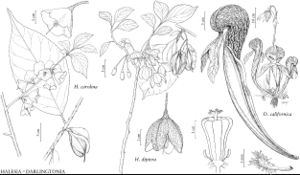Difference between revisions of "Darlingtonia californica"
Smithsonian Contr. Knowl. 6(4): 5, plate 12. 1853,.
FNA>Volume Importer |
FNA>Volume Importer |
||
| Line 47: | Line 47: | ||
|publication year= | |publication year= | ||
|special status= | |special status= | ||
| − | |source xml=https://jpend@bitbucket.org/aafc-mbb/fna-data-curation.git/src/ | + | |source xml=https://jpend@bitbucket.org/aafc-mbb/fna-data-curation.git/src/f6b125a955440c0872999024f038d74684f65921/coarse_grained_fna_xml/V8/V8_685.xml |
|genus=Darlingtonia | |genus=Darlingtonia | ||
|species=Darlingtonia californica | |species=Darlingtonia californica | ||
Revision as of 21:30, 24 September 2019
Pitchers with white areolae, 4–6(–10) dm, neck ca. 1 cm. Scapes 5–10 dm; bracts yellowish, 1–3.5 cm. Flowers: sepals yellow-green, 3–6 cm; petals reddish brown with larger veins darker, 3.5 cm; stamens 10 mm; filaments 5 mm; abaxial anther sacs 6 mm, adaxial ones 4 mm; ovary 1.5 × 0.5 cm at base, to 1.3 cm diam. at apex; style 5 mm, lobes 3 × 1 mm. Capsules 3.5–4.5 × 1–2.5 cm. Seeds 2–3 × 1 mm. 2n = 30.
Phenology: Flowering mid Apr–Jul.
Habitat: Marshy streams, seeps, and bogs overlying serpentine soils
Elevation: 0-2600 m
Distribution

B.C., Calif., Oreg., Wash.
Discussion
Within California, Darlingtonia californica is disjunct from Del Norte County in the northwest to Nevada County southeasterly in the Sierra Nevada, and introduced in Humboldt and Mendocino counties. In Oregon, it occurs in the coastal lowlands and inland mountains of Curry and Josephine counties northward to Tillamook County. It is introduced on Vancouver Island in British Columbia, and in southern Washington. It may form relatively large stoloniferous colonies on mountain slopes or meadows and in coastal lowlands, or in shallow streams and seepage bogs. The flowers are initiated in the fall and overwinter in the bud stage, protected by the bracts. The fruits mature in late summer to fall, with seed dispersal continuing throughout the winter. The long papillae on the seeds allow flotation.
Darlingtonia californica is stunning in the wild, eagerly sought for cultivation, and difficult to grow outside its cool native range. It was discovered in 1841 on the Wilkes Expedition by the assistant botanist, W. D. Brackenridge, growing in a marsh bordering a tributary on the Sacramento River south of Shasta Peak. It is currently threatened by road building, draining, logging, ranching, drought, and unscrupulous collectors. Darlingtonia and some eastern American species of carnivorous plants have been transplanted into sites in northern California and the Pacific Northwest.
Selected References
None.
